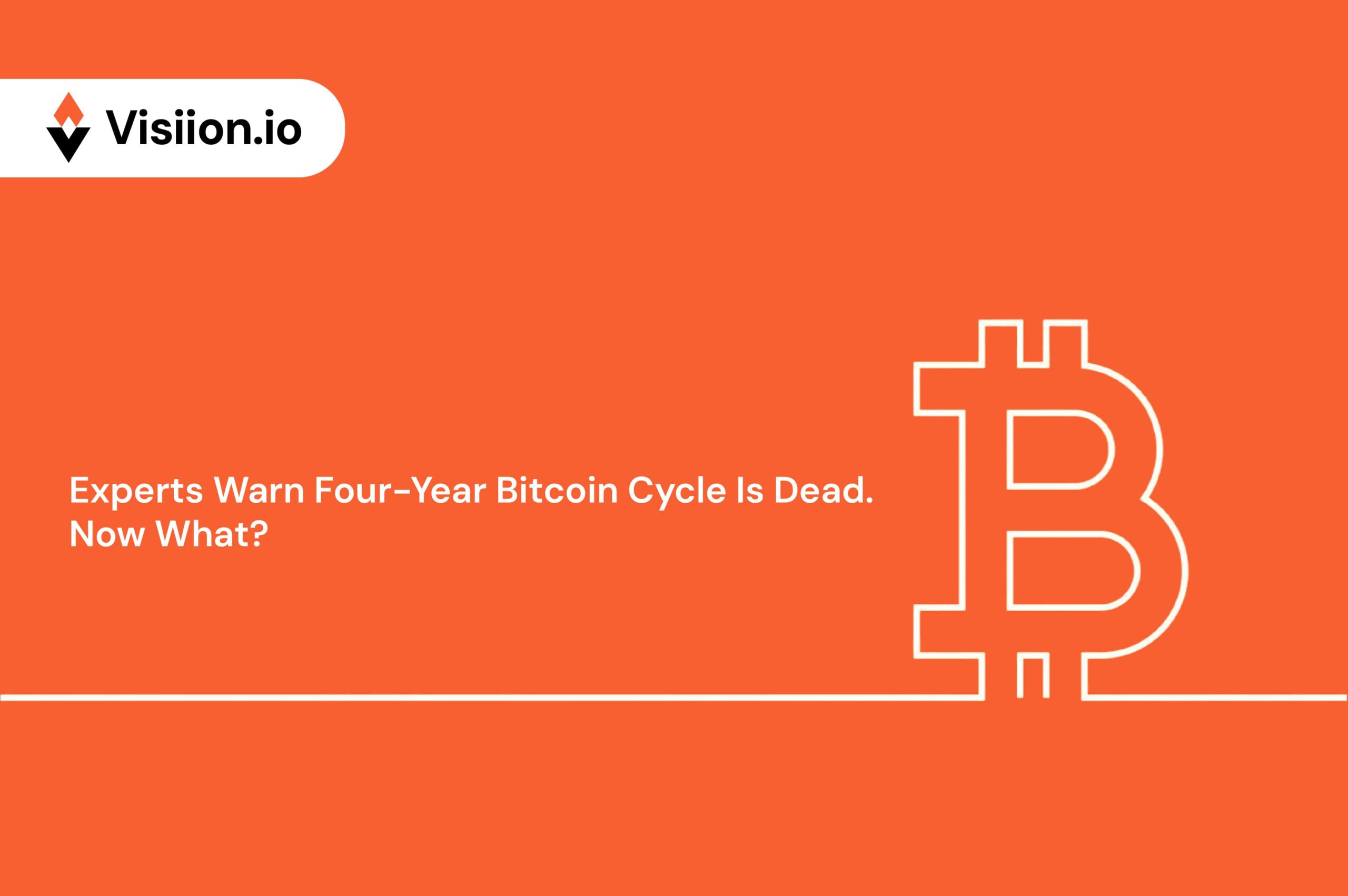Experts Warn Four-Year Bitcoin Cycle Is Dead.
Now What?
Like a lot of assets, Bitcoin has traditionally moved according to a standard set cycle, more or less. According to experts, these Bitcoin cycles were roughly 4 years. But that pattern is changing now.
What used to look like a clean four-year rhythm now feels like a messy jazz set, unpredictable, nonlinear, and shaped by a new set of players. Analysts, researchers, and trading desks across the space have spent the last year trying to understand what exactly is going on.
They’ve looked at price patterns, ETF flows, macro factors, institutional behavior, and historical halving data. And across the board, the conclusion is the same: the four-year Bitcoin cycle doesn’t drive the market like it used to.
In this article, we will walk you through what changed, why the halving isn’t the market mover it once was, and how institutional money reshaped the landscape. We will also talk about what metrics actually matter now.
The Classic Four-Year Bitcoin Cycle
Back in the day, Bitcoin’s behavior looked almost too perfect. Every four years, the block reward for miners would be cut in half. That halving created a supply shock. Fewer bitcoins entered circulation, while demand stayed steady or spiked. The price would skyrocket within 12 to 18 months. Then it would crash. Then it would consolidate. Then the buildup would begin again.
People called it the Bitcoin Halving Cycle.
You saw this in 2012, 2016, and 2020. The charts looked like echoes of each other. Accumulation → markup → blow-off top → bear phase → re-accumulation. It looked like clockwork. Whole trading strategies were built on it. Analysts set their clocks to it.
But these Bitcoin cycles rely on consistent behavior. That’s where the problem started.
When the Clock Stopped Ticking
By 2025, something broke.
Bitcoin crossed $123,000 months after the 2024 halving, but without the same retail mania or halving-driven narratives fueling it. In fact, the April 2025 peak had little to do with the halving at all. It aligned more closely with ETF inflows, macro easing signals, and a string of large-cap institutional buys.
Even Ki Young Ju, CEO of CryptoQuant, said it plainly: the old halving model failed. He had previously predicted a ceiling around $80K post-halving. But the price blew right through it. And not because retail was foaming at the mouth. Because institutions were quietly building positions. Because demand stayed steady while supply became less relevant.
This points to something deeper. But what exactly? Well, time to find out!
Institutions Shifted the Ground
Once BlackRock, Fidelity, and other major asset managers entered the picture, everything changed. These players don’t trade like early adopters. They’re slow, strategic, and most importantly, conservative. But they bring serious weight. When they buy, they hold. When they allocate, they diversify. When they move, it’s after internal committee approval, not a YouTuber screaming “bull run!”
Between early 2024 and mid-2025, institutional holdings of Bitcoin via ETFs and custody platforms increased by over 300%. Corporate treasuries added exposure. Hedge funds diversified into spot assets, not just futures, and pension funds finally got regulatory clarity. These flows are sticky. They’re not reactive like retail. They don’t buy parabolas and sell panic.
And crucially, they don’t care about the halving.
They care about portfolio fit, inflation hedges, non-correlated assets, and long-term yield optimization. The old halving narratives, “only 900 BTC are mined per day now!”, don’t excite a fund manager looking at 10-year duration bonds and equity risk premia.
Halving Still Happens, It Just Doesn’t Hit the Same
Yes, the halving is still real. Miner rewards dropped from 6.25 BTC to 3.125 BTC per block in April 2024. That’s significant for miners. But what is the impact on price? Not so much.
The reason is pretty simple. Now that the market has matured, it already prices these things in. Efficient markets are immune to scheduled events. The halving was known years in advance. Any investor, from retail trader to Wall Street quant, could model the reduction in supply.
Plus, miners are changing their behavior. In fact, miner selling pressure dropped due to diversification strategies, selling BTC options, earning staking rewards on alt holdings, or raising fiat via treasury tools.
What used to be a supply shock became more of a mild ripple. There’s still an impact. It just isn’t that prominent.
What Actually Moves the Market Now?
Here’s what analysts are more interested in instead of the Bitcoin cycle:
- ETF Net Inflows:
Daily ETF subscription data now acts as a proxy for demand. When spot ETFs see strong inflows, the price tends to climb.
- Macro Policy
Bitcoin behaves like a risk asset when interest rates rise or fall. Correlation to tech stocks has increased, not decreased.
- On-Chain Dormancy
Long-term holder metrics show whether coins are being moved or held. Dormant supply at ATHs means strong holder conviction.
- Liquidity Depth
Order book data shows where major buys/sells sit. Thicker books around key levels can suppress volatility.
- Global Regulation
Clarity in the U.S., EU, and parts of Asia opens doors for new classes of capital. Delays or bans, meanwhile, restrict flows.
So while halving still affects miner economics, these are the variables that actually move BTC day to day. The four-year clock got drowned out by a dozen louder signals.
It’s a Numbers Game
If you’ve still got doubts about what we are talking about, let’s take a look at some numbers. We all know that numbers don’t lie, right? So here’s a quick overview of how Bitcoin prices behaved post-halving:
- 2012 Halving: Price rose 8,800% within a year.
- 2016 Halving: 294% gain post-halving in the next 12 months.
- 2020 Halving: Roughly 540% rally leading into late 2021.
- 2024 Halving: Around 30% increase in the three months following the event.
You don’t need to be a quant to see the curve flattening. As market cap expands and trading activity becomes institutionalized, volatility compresses. So does the “oomph” behind each halving.
What Traders Got Wrong?
Now this is very interesting. Many short-term traders in 2024 and early 2025 bet big on the Bitcoin cycle repeating.
They charted it, modeled it, and some even built high-leverage positions expecting the post-halving surge to follow previous patterns. When the price action lagged or moved differently, they got wrecked.
Crypto X lit up with angry threads. Subreddits debated whether the Bitcoin cycle was delayed or dead. Analysts released reports re-evaluating their forecasts.
The common thread? They all underestimated how much the market had matured.
While Halving was still here, it just lost its grip. So, what are the new drivers that impact Bitcoin prices now? Let’s take a look.
New Structural Drivers
There is no definitive guide on these price drivers. There are numerous factors at play now. But some of the most important ones that affect Bitcoin prices are:
- ETF demand and institutional flows shape short- and mid-term moves
- Long-term holders control more than 70% of the BTC supply
- Liquidity is deeper, volatility is lower, and distribution takes longer
- Regulation now dictates participation from banks, pension funds, and sovereigns
- Bitcoin correlates more with macro indices and equities than with itself
Supply Shocks Mean Less Without Panic Buying
In the past, fewer coins hitting exchanges post-halving triggered major spikes. But now, buyers don’t chase price the same way. Institutions don’t care if they get in at $102K or $108K. They just want clean exposure and multi-year security. That dampens panic bidding.
At the same time, more BTC sits idle. Over 70% of coins haven’t moved in a year. That makes markets less reactive. Sudden dumps are less common. Slower moves dominate. The market looks more like gold, less like meme stocks.
Some Still Believe the Cycle Lives
Not everyone agrees that the four-year Bitcoin cycle is dead. Some chartists still expect a blow-off top by late 2025. They point to repeating volume patterns, RSI symmetry, and fractals from previous cycles. Others suggest we’re just in a stretched version of the 2020 structure. They expect a late-stage mania phase sometime around Q1 2026.
While these speculations are not, they are exactly what they are: speculations! And more often than not, based on technical echoes rather than structural realities.
Cycles are used to describe the market. Now they try to predict it.
What This Means for the Market Going Forward
Markets with institutional involvement tend to behave differently. They’re slower, but more stable. They don’t overshoot as much. They don’t crash as violently. Drawdowns still happen, but they’re more like corrections than free-falls.
As Bitcoin matures, it’s less about magic patterns and more about real flows, political narratives, fiscal policy, adoption, and allocation models. That’s the new dynamic.
Traders who rely on old Bitcoin cycle models may find themselves misaligned. Institutions, on the other hand, are likely to treat Bitcoin like they treat commodities, FX, or large-cap equities, slow-moving, strategically held, and rebalanced quarterly.
What to Watch Instead of Halving?
- ETF creation/redemption activity
- Federal Reserve rate signals and bond market movements
- Stablecoin inflow/outflow trends
- Long-term holder dormancy waves
- Miner outflow behavior and hashrate migration
A Broader View of Bitcoin’s Maturity
The Bitcoin network doesn’t care about price. It keeps producing blocks every 10 minutes. The reward drops every four years. But the people trading, buying, holding, and building around it? They’ve changed.
It’s no longer a handful of Redditors and Telegram groups moving markets. Now it’s asset allocators. Corporate CFOs, bank trading desks, global regulators, macro hedge funds, insurance carriers, and even sovereign wealth funds.
That reality changes everything.
Final Word
The four-year Bitcoin cycle worked, for a time. But the market outgrew it. New capital flooded in. New rules emerged. New motivations replaced old ones. Bitcoin’s dynamics matured. The old playbook stopped working.
Cycles might still show up in charts. People might still use them as frameworks. But they don’t run the show anymore. Demand, infrastructure, liquidity, and regulation do.
And that’s the story of 2025. But to be honest, crypto markets have a tendency to offer shocks! So it’s entirely possible that experts who are suggesting Bitcoin’s 4-year Bitcoin cycle is over, might be entirely wrong!
The only way to be sure about this is to wait and watch!
We hope this blog has offered you a new angle on how you look at Bitcoin pricing. If you liked this blog, don’t forget to check out our other blogs. You will surely find some really interesting information.
Till then, trade safe, be safe.










